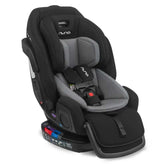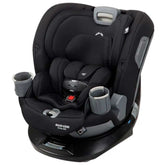Baby Feeding Schedule: How Much Should a 0 to 3-Month-Old Eat?

Once you finally arrive home with your sweet new baby, it’s time for you to settle in and start getting to know one another. Part of those first few weeks with your newborn is about getting to know one another and learning to read the signals from both your baby’s body and your own. The days and nights begin to melt into one another as you try to adapt to your baby’s round-the-clock feeding needs. Eventually, life will settle into a pattern that resembles something a little closer to an actual routine.
Whether you decide to feed your baby formula, breast milk, or both, calculating just how much your newborn needs can feel a bit daunting. Many parents (especially those who breastfeed) are concerned their baby isn’t getting enough. And regardless of all the helpful advice from well-meaning older relatives, newborn feeding recommendations have changed since you were a baby. Doctors now advise that all newborns, even formula-fed ones, eat on demand and that babies wait to start solid foods until they’re 4 to 6 months old. To ease your anxiety, we’ve outlined a general guide to give you a rough idea of how much milk a typical newborn needs during the first three months.
How much should a 0 to 3-month-old eat per feeding?
Newborn infants can only hold a tiny amount of milk at a time, so it takes very little to fill them up. At birth, your newborn’s stomach is no bigger than a toy marble (about 1 to 2 teaspoons). By day 10, your baby's tummy grows to the size of a ping-pong ball (about 2 ounces). Eventually, their stomachs will expand to adjust to larger amounts of food.
Your baby may eat only about half an ounce at each feeding for the first couple of weeks and up to about 1 to 3 ounces per feeding after that. This can be difficult to measure with breastfed babies, so doctors recommend about 5 to 20 minutes of nursing on each breast.
How often should a 0 to 3-month-old baby eat?
Every baby is different, but breastfed infants typically need to eat more often than bottle-fed babies. The reason? Breast milk is so efficiently digested that it leaves their tummies a lot faster than formula.
Nursing babies
As anyone who’s ever done it can tell you, breastfeeding is exhausting. Within an hour of birth, you should begin breastfeeding your baby and continue feeding about 8 to 12 times per day for the first few weeks, according to La Leche League International. Until breastfeeding is well established and they’re regaining their birth weight, newborns shouldn’t go more than 4 hours between feedings. (That means you may need to wake them up to eat occasionally.)
As your little one gets older and your milk supply increases, they’ll be able to eat more in a single feeding. It’s also when you may be able to identify a more predictable feeding routine.
Bottle-fed babies
Just like nursing infants, it’s now recommended that bottle-fed newborns eat on demand, typically about every 2 to 3 hours. For example, an average daily feeding schedule may look like this:
- Newborn: Bottle-feed every 2 to 3 hours
- Around 2 months: Bottle-feed every 3 to 4 hours
- By 4 to 6 months: Bottle-feed every 4 to 5 hours
Keep in mind that every baby is unique. Different babies will have different routines and preferences, along with other elements that affect the frequency of feedings.
Feeding Tips for Both Breastfed and Bottle-Fed Babies
- Adapt to your baby’s unique needs. Preemies or babies with reflux may need to follow an adjusted feeding pattern. Work with your pediatrician to determine what is best.
- Never put baby cereal in a bottle. Not only is a newborn’s digestive system ill-equipped to handle it until about 4 to 6 months of age, but it also creates a potential choking hazard.
- Avoid giving babies any fluids except formula or breast milk until they’re at least a year old. Juice and cow’s milk can upset an infant’s immature digestive system and don’t provide the appropriate nutrients anyway. Water can be given around 6 months when you begin offering a cup.
How will I know if my 0 to 3-month-old baby is hungry?
For babies with certain medical issues or those born prematurely, scheduled feeding sessions may be necessary. However, for most healthy, full-term newborns, caregivers should watch their baby (instead of the clock) for hunger cues. This is known as feeding on demand, or responsive feeding.
As you get to know your baby better, you’ll start to recognize their individual hunger cues. This can help you get your baby fed and comforted before they even start fussing. Here are some common signs that your baby might be ready to eat:
- Rooting reflex (turning their head to the side, mouth open)
- Nuzzling your chest
- Sucking on hands, fingers, or anything else nearby
- Licking their lips
- Opening their mouth and/or sticking out their tongue
- Crying or fussing
Comotomo Baby Bottles (8 oz., 2-pack) have smart, non-leaking dual air-vents to prevent colic, a truly wide-neck design for easy cleaning, and a hygienic silicone material so that you never have to worry about toxic chemicals. Above all, Comotomo bottles are designed to mimic breastfeeding to help babies easily transition back and forth from nursing to bottle feeding.

Comotomo Baby Bottles (8 oz., 2-pack)
How will I know if my 0 to 3-month-old baby is eating enough?
No matter how you choose to feed your baby, they will seem full and satisfied if they’ve gotten the right amount of food. If they’re still hungry, you’ll usually know by their disposition. For example, they may cry or continue to want to suckle after a feeding session. However, this could also be an indication of other issues, such as reflux, colic, or gas.
Counting the number of wet diapers per day is another great way to tell if your newborn is eating enough. In the first few days after birth, your infant should have two to three wet diapers each day. After the first four to five days, a baby should have at least five to six wet diapers a day. The urine should be pale yellow. How often your baby poops is more variable and depends on whether your baby is breastfed or formula fed.
Monitoring your newborn’s weight gain can also help you evaluate whether they’re feeding enough. Your pediatrician will weigh your infant and track their progress on a growth chart. Newborns who remain within a healthy growth percentile range are probably getting plenty of food during feeding sessions.
If you are concerned that your newborn may not be eating enough or they are not having enough wet diapers, talk to your pediatrician as soon as possible. They can investigate any potential underlying problems and help you come up with a nutritious feeding plan for your baby.
The Takeaway on 0 to 3-Month Old Feeding Schedules
While wondering whether your baby is getting enough to eat can make many caregivers quite anxious (especially during the first three months), take comfort in knowing that all is probably well as long as your baby is growing and has enough wet diapers.
Let your newborn lead the way by allowing them to eat when they’re hungry and stop when they’ve had enough. In the end, well-checks with the pediatrician are the best way to determine whether your baby is eating well and developing at the speed that is right for them. If you have concerns, it’s always best to reach out to your doctor sooner.










